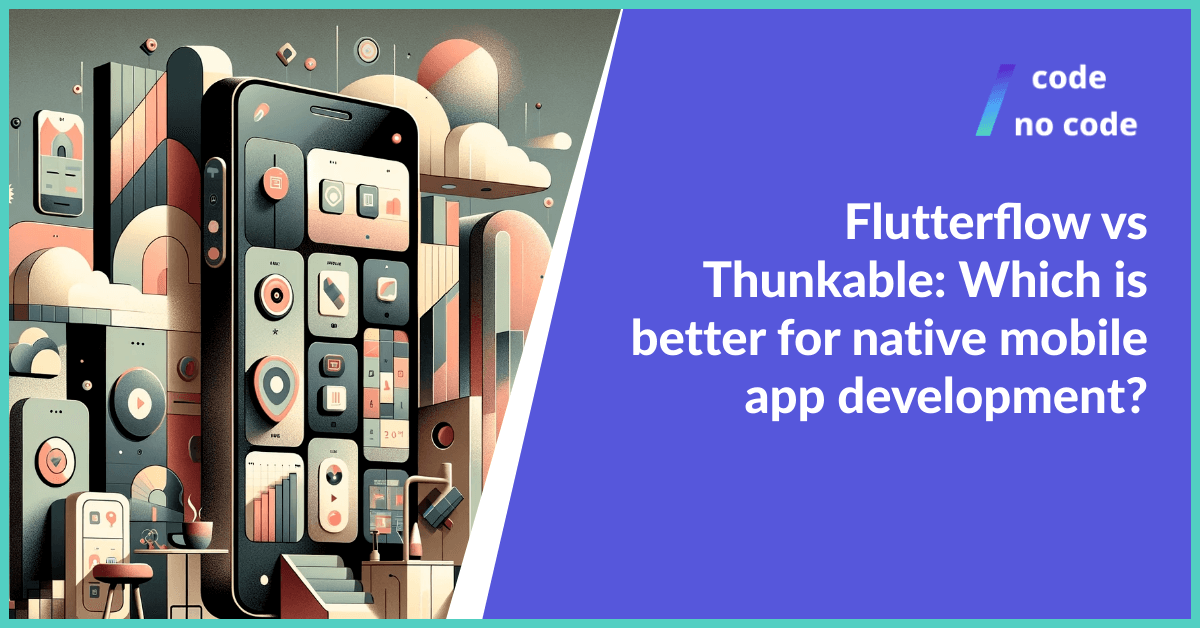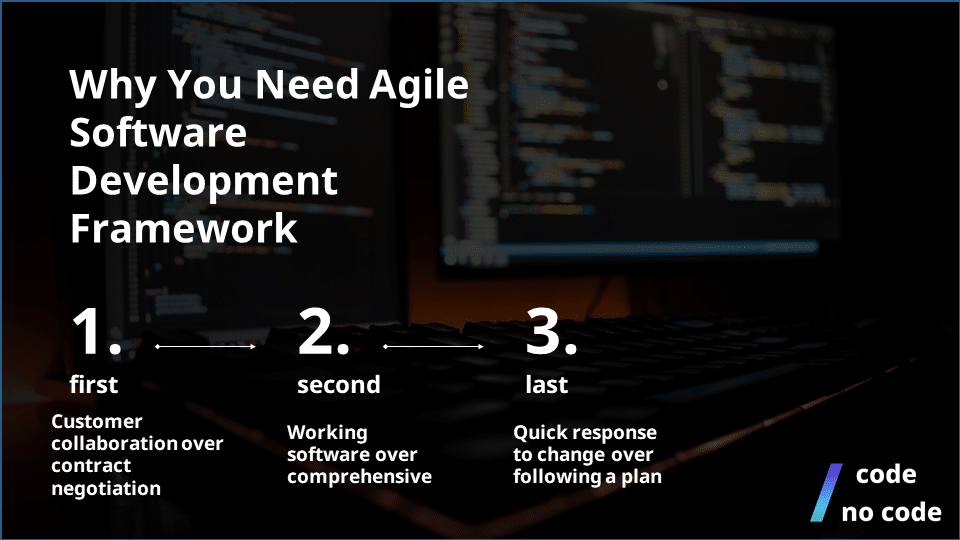
Flutterflow vs Thunkable: Which is better for native mobile app development?
Choosing the right Low Code tool for mobile app development can be a headache. There are many options available, and it’s important to select the one that...
It’s no secret that some of the most prominent names[1] across different industries like Barclays and Cisco have benefited largely from Agile transformation. Many of them use a different Agile approach to the other. These variant approaches are professionally termed “Agile frameworks”, and there are a lot of them.

Even the most recent business trend of using No Code/Low Code platform development employs these standards.
On the off chance that you are unfamiliar with the Agile movement, you should first know that it is a project management philosophy. The Agile software development methodology is incremental and iterative by nature. And while Agile frameworks are primarily utilized in software development, you can scale Agile to any organization in any industry.
With such a wide variety of industries applying different Agile management approaches, it’s clear we need to understand the difference between most of these frameworks. More importantly, how do you decide which Agile process is best for you?
This article will answer your questions and help guide you through to choosing the best Agile frameworks for your projects.
But first, we need to have a solid grasp of the substratum of this topic, Agile methodology.

There wasn’t really any technical meaning to the term Agile (and now Agile methodology) until 2001. This was when a community of developers grew frustrated with the apparently “heavy” waterfall model. Inspired by that, they established the Agile Manifesto.
This holy grail document[2] was so impactful that it functioned as an enchiridion for Agile development even to this day. It is the official document laying out all the Agile principles, values and good Agile practices for successful implementation in industries.
The values of Agile development centered around customer collaboration in preference over contract negotiation; emphasis on individuals and interactions as opposed to processes and tools; comprehensive documentation taking a backseat to working software, and responding to change over sticking to a plan.
On that note, you can think of an Agile framework as a specific approach for developing software based on the Agile philosophy as defined in the Agile Manifesto. It’s okay to refer to these frameworks as processes or methodologies.
Development teams working using many of these frameworks tend to modify sections of the frameworks uniquely to suit their ideals.
You can also use these frameworks with No Code tools to make your development around five times faster. Read our article about What is No Code to find out more!
Below you’ll find our brief conspectus on some of the well-documented and most popular agile frameworks for adaptive software development.
| Practices | Scrum | Kanban | Lean | XP | Crystal | DSDM |
| Approach | Iterative and Incrementall | Small evolutionary increments | Eliminate wastes and Optimize efficiency | Iterative increments | Iterative approach | Iterative and Incremental |
| Time | 2-4 weeks | Continuous Improvement | Not time-bound | 1-6 weeks per iteration | 2:8 ratio of time to solution | Frequent improvements |
| Team Size | 5-9 members | Small to medium | Small Project – 6-9 members | 2-12 members | Independent and self organizing team, 2 -10 members | 6 or more members |
| Scalability/Suitable Project size | Scalable, therefore, suitable for all types and size | Any size and type | Any type or size | Relatively small projects | All types and size | Small to intermediate sized projects |
| Major Practices | Product backlog, Burn-Down Chart, Product Vision, Sprint Backlog | Kanban board, stickies | Value-add activities, Waste elimination and Non-Value Add (NVA) activities | User stories, Pair coding, Refactoring | Feasibility and business study, Prototyping | Crystal Family, Criticality |
Some of the most popular and efficient agile software frameworks include:
The first framework we will look at is Scrum. Scrum is one of the most popular Agile frameworks, and for good reason. It is a simple Agile framework that can be adapted to any size team or project. It is a flexible and adaptable framework that can be used for projects of all sizes.
Scrum is based on the principle of iterative and incremental development, which means that Scrum teams work in short cycles, or sprints, to deliver features. A Scrum team is meant to be self organizing by nature as opposed to being hierarchical and the sprints they work in is typically confined to two week intervals.
Scrum, with its emphasis on structure and process, is a good choice for teams that want to be closely managed by a dedicated project manager. Scrum enables individual management of different sprints of the project in development.
Scrum limits mistakes, as the workflow is divided into parts to simplify activities. The division results in a product of quality value. However, dividing the workflow into segments may cause the team to develop the project in fragments rather than developing a holistic product.

Kanban is a Japanese word for a visual board. Kanban framework is a tool that organizes tasks into boards or tables on a board. The framework uses visual elements to manage projects.
Kanban is another popular agile framework that emphasizes continuous improvement and incremental delivery. It’s perfect for large organizations because it is an easily scaled Agile framework.
The Kanban board resembles a table with rows and columns, capturing the progress made in the development project. As the project team makes steps in improving a project, the information on the Kanban board changes.
A new card is created in the table when new tasks are added. Kanban board ensures that the status of all stages in an existing or new project is visible to all team members.
Viewing the status of all projects in development is important. By seeing the tasks, the team reduces the number of projects they work on since the status of all projects is visible. All the members know where to channel their strength, ensuring continuous delivery of results.

The Toyota manufacturing company created the Lean concept to gauge the effectiveness of an activity as they manufacture their products. Now, the concept has found its roots in many Agile software development projects.
The essence of all activities in a project is cumulative and should be valuable to the end-user. Lean development helps business teams optimize development time and tools so that the final product is tailored to user requirements.
The Lean software development process makes use of the Minimum Viable Product (MVP)[4] strategy. This entails releasing a trace version of the software, followed by observation of end-users’ preferences and dislikes.
Based on the user feedback, the software development teams make iterations until the desired final product without losing the initial conceptual integrity.
The intent of the LSD methodology is to ruthlessly eliminate any activity or feature that does not have direct effect on the end product.
However, it is worth noting that for product success using the values and principles of this framework, the organization must have implicit trust in their Agile teams.

Out of all the Agile methodologies, Extreme programming (XP) has the highest level of customer involvement. Customers are an active member of the development team throughout the project life cycle.
Extreme Programming is an especially honest Agile project management framework that emphasizes the broad philosophy of Agile development – producing high-quality software for customer satisfaction.
It operates using a test-first Agile processes scheme within short-term time stints.
XP ensures soaring collaboration between customers and developers of the product, resulting in a well-organized delivery of the project to the customer. However, it requires that the team of developers is relatively small and capable of leveraging on technology to enable functional tests and automated units.

Crystal is an Agile framework that emphasizes one of the core Agile values by prioritizing individuals and their interactions over tools and processes.
Typical Crystal agile processes include:
The nature of the Crystal method is viable for organizations who want to empower their Agile teams to determine how the workflow should go.

The Dynamic Systems Development Method is an Agile project management framework that emphasizes iteration, adaptive planning and other Agile practice concepts for project success.
The framework states explicitly that “any project must be aligned to clearly defined strategic goals and focus upon early delivery of real benefits to the business”.
The framework builds on the foundation of four principles: functional model and prototype iteration, feasibility and business study, design and build iteration, and implementation.
Like Scrum, DSDM utilizes the concept of workflow sprints. Using the concept, the quality of the product is retained, as the sprints are delivered on time.
The concept of the agile framework depends on the four core values tagged in the agile manifesto. The values are Individuals and interactions over processes and tools; Customer collaboration over contract negotiation; Working software over comprehensive documentation; Quick response to change over following a plan.

Agile software frameworks help teams to deliver products that improve every time. With the framework, the team’s delivery of value is consistent. In addition, good frameworks ensure the team addresses challenges in a timely manner.
Agile frameworks increase the variety of shared ideas, prioritizing people over tools. It focuses on small changes per time. These software frameworks help to establish and build relationships with the team and client, reducing technical debt. It guarantees the delivery of beneficial products/projects of high quality that ultimately result in client satisfaction.
Besides the above-listed frameworks, there are even more great Agile frameworks; Test Driven Development, Behavior Driven Development, Disciplined Agile, Scaled Agile Framework, among others.
That being said, you should know that there is no best framework or even best practice across these frameworks. There’s only good practice within a certain context.
Nevertheless, there are factors you can watch out for to guide you to choosing Agile software frameworks
When it comes to agile software frameworks, there are a few that stand out among the rest. The most popular frameworks are Scrum, Kanban, and XP. All of these frameworks have their own benefits and drawbacks, but each one is still a viable option for agile teams.
Agile software development frameworks can be combined with No Code tools to make your development lightning fast. You can read our article about What is No Code to find out more.
Also, don’t forget to follow us on Twitter to get regular updates on the No Code industry.